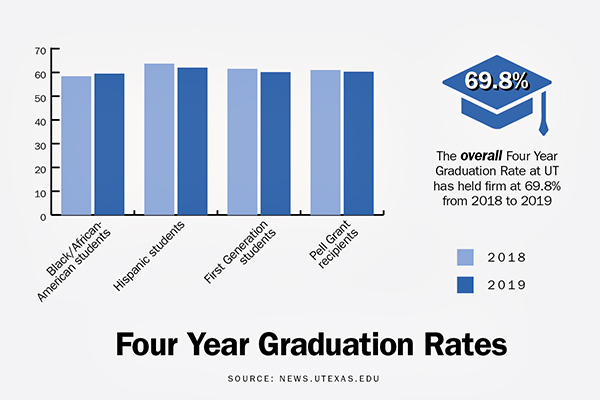Editor's Note: This story has been updated since it was originally published.
The University’s four-year graduation rate didn’t change since last year, according to a UT press release.
Overall four-year graduation rates remain fixed at 69.8% since 2018 after rising gradually from 55.1% in 2014. Six-year graduation rates, however, have improved by 2.8% since last year to a rate of 85.6%.
According to the press release, the University set a goal in 2011 to increase the four-year graduation rate from 52% to 70% by 2017. The graduation rate hit 65.7% by 2017 and has not reached 70% since then.
“When we were aiming for 70%, that (was) an aspirational goal,” University spokesperson J.B. Bird said. “To achieve improvements, especially rapid improvements like that, it helps to set a challenging, aspirational goal.”
According to the press release, the University implemented various campus-wide programs and analyzed data in 2013 to provide graduation support for students. Programs offered by the University include 360 Connections, small communities of students, and the University Leadership Network, which provides scholarships and opportunities to select freshmen with financial need.
“(The six-year increase is) going to be the outcome of all the student success programs,” said Joey Williams, director of communications for the Office of the Executive Vice President and Provost. “What you are seeing now is the fruition of that.”
Graduation rates for Hispanic, first generation and Pell Grant-eligible students have increased in the past five years, but they all saw slight decreases from last year.
The four-year graduation rate of first-generation students, which increased nearly 17% within the past five years, dropped this year to 60.1% from 61.5% in 2018. The same graduation rates decreased about 1.6% for Hispanic students since last year and by 0.8% during the same time period for Pell Grant-eligible students, or students who qualify for federal subsidies for college.
Bird said as the overall four-year graduation rates increase over time, variations are expected. UT is still well above the national average four-year graduation rate, which sit at about 41%, according to the National Center for Education Statistics as of 2011.
“You can’t always go up,” Bird said. “The further … you succeed from the norm, the harder it is to continue the increase.”
Bird said Fenves has previously said he wants to continue to improve the University’s rates, but it is difficult for them to be as high as rates at private universities.
“The way we admit students, the kind of students we admit, and the way that they pursue their degrees is different than private institutions,” Bird said. “The characteristics of our student body, the kind of people that we try to serve, and the kind of approach we take will never be like an elite private school in terms of our four-year graduation rates.”
Bird said the University hopes that the overall graduation rates will increase.
“I think the overall thing is to look at the major upward trend over the past five our six years,” Bird said. “It’s really on all of us — the University, and students working together. We want to continue to see improvements.”
The four-year graduation rate for Pell Grant-eligible students, students who qualify for federal subsidies for college, has also increased about 16% in the past five years. The rates for African American students increased by 16.4% and rates for Hispanic students also increased by nearly 20% in the past five years.





















